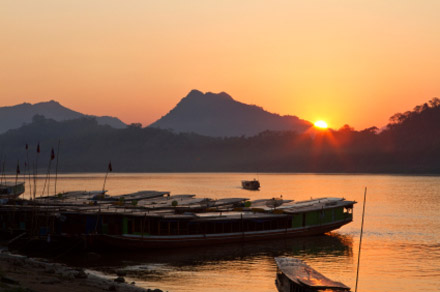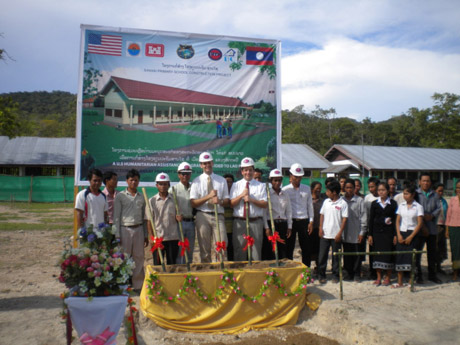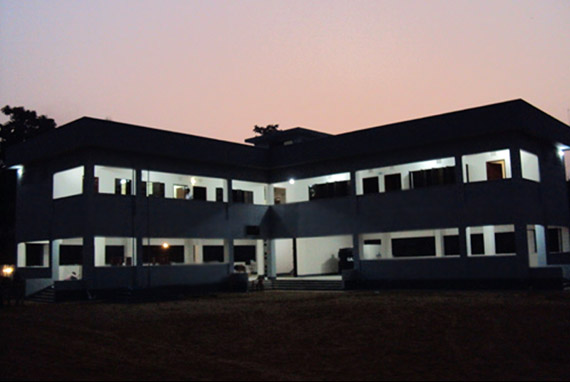USACE’s International Services: “Solutioneers” with a Lighter Touch
Most people know the U.S. Army Corps of Engineers (USACE) as a 37,000 person-strong organization that executes large military construction programs or builds and maintains massive civil works projects like the navigation locks up and down the Mississippi River or the Bonneville Dam hydropower project on the Columbia River. But, the interagency and international components of the Corps are what Jim Balocki, USACE Chief, International and Interagency Services, describes as the “lighter touch of who we are.” This includes things like putting street lights in the City of Kabul, Afghanistan. Many may wonder why the Corps would care about such a seemingly mundane thing, but, according to Balocki, “It’s bigger than that. It’s about bringing security to a region, which then leads to something much more profound.
“We recognized the security and quality of life challenges when we talked to the Mayor of Kabul. So we found funding through a commander’s Emergency Response Program, and one of the USACE Districts there delivered about 50 solar-powered street lights, which were able to illuminate an important part of the City. That doesn’t seem like much. But, people can now go out at night. This helps to build an economy, and it helps to create stability in a place where they haven’t known any. This was expressed through the opening of stores in the evening and the ability to conduct commerce after dark. The people are now able to move freely and without fear for their lives in an area of town that had been, heretofore, relatively crime-ridden. Fifty street lights on a couple of sides of a divided road – it didn’t even cover 10 or 15 blocks – but it brought security and economic benefit to those people.” (Read Kabul & The Power of Street Lights.) This is a small but typical example of the smart, high pay-off projects that best exemplifies what USACE International Services is all about.
Universe of Services
In fiscal year 2011, USACE International and Interagency Services partnered with 70 different entities of the U.S. federal government, which include: Department of State, Customs and Border Patrol, Environmental Protection Agency, Department of Interior, Department of Veterans Affairs, Department of Homeland Security and Department of Energy. The organization executed almost $2.5 billion in work, but the bottom line is this was accomplished with the capabilities the Corps has on behalf of the Nation as part of the federal government. The other agencies, according to Balocki, “don’t have and, frankly, can’t afford these types of capabilities as a force in being, especially in these tough economic times. We have specialists in many different unique areas that others just can’t afford to have.”
In addition, USACE International Services also supports foreign governments and international organizations, such as the World Bank and the United Nations, the latter largely in water resources and development projects in Kenya and other parts of Africa. The Corps also works with the World Water Council on global water issues, on how they affect humankind and on what can be done, collectively, to address these concerns. They also support state and local governments through some of their authorities. This includes work done for New York City to help assess their water supply.
Balocki explains they also “support science and technology exchanges. In that domain, most notably, we’re working with China in water resources, and another interesting example is Vietnam.

© iStockphoto.com/joakimbkk|Mekong sunset on the riverbank of Luang Prabang, Laos, SE Asia.
The latter is concerned about development on the upper regions of the Mekong River. Some countries, like Laos and China, have proposed to put dams on the Mekong in the main stem of the River, which the Vietnamese assert will impact the sediment flow to the Mekong Delta. The Mekong Delta is, of course, a unique ecosystem on Earth that they’re concerned about preserving for its economic as well as its subsistence-food generating value. It’s part of their livelihood. So, we’re involved with a group of countries on the lower Mekong to help advise them through the State Department.”
Balocki suggests that the Corps’ success in teaming and partnering may be due to its unique make-up. “The U.S. Army Corps of Engineers is who we are, absolutely. But, because 36,000 of the 37,000 people who make up the Corps are civilians, it creates long-standing professional relationships, which endure throughout many years and, in some cases, many decades. It gives us unique insights into what the real roots of issues are – things others may miss.
“We do our work on behalf of others. In other words, these aren’t our great ideas; they’re the great ideas of others. Our requirement, then, is to bring to bear the intellectual capital that’s the Corps of Engineers – the science, engineering and technology – to solve a problem, whether that’s as simple as putting streetlights on a street or as complex as building a garrison for an Afghan Army Brigade.”
Litmus Tests for Project Selection
USACE International Services is about security, and security comes in many different forms. According to Balocki, “Sometimes, it’s standing post on a guard tower with a weapon pointed outside the perimeter, but sometimes it’s a civilian woman or man living amongst the people delivering basic services to the betterment of that community. Security is a spectrum. Sometimes one is called for, but, I would say, many variants along that spectrum are necessary.”
The first litmus test for project acceptance is: (1) Is it within USACE authorities; in other words, is it legal? The Corps extensively screens new requests, which are unlike those they have received before. If it passes this test, then (2) does the project request fall within one of the Corps competencies? Do they have the skill-set resident or can they oversee someone to do it? If yes, they (3) pass it through a capacity test. This is usually not a problem because the organization leverages enormous contract capacity throughout the world. It can, however, be an issue related to their capacity to oversee the work to ensure it is completed properly on behalf of the client. Once the project is approved, USACE returns a cost estimate relative to the requirements and needs, which the client will generally pay for.
While each client is different, the needs and requirements are usually within USACE corps competencies, thus making most requests something the Corps is familiar with and comfortable executing. “Some of these requests may stretch us, such as providing energy solutions, which are the most suitable and feasible for sustainable energy challenges,” explains Balocki. “That’s really stretching us in a lot of ways. We’re also seeing more and more climate change-related issues, particularly in our Institute for Water Resources (IWR). IWR has several preeminent authorities on climate change who are deeply involved in many of the things we do internationally in water resources. That seems to be an omnipresent subject area and one with a common thread across humanity – how to share water resources. This is an area we find ourselves in everyday.
“One upside is that we’re becoming more comfortable and more familiar with the idea that a client may just as easily be the Department of Homeland Security or the government of Vietnam. It doesn’t matter as long as it’s legal, and we have the core competency and capacity to do it. If it brings value to this Nation, it’s good work. Maybe this philosophy is more indigenous to our younger workforce because they seem to be comfortable working in this type of multi-faceted, multi-cultural environment, particularly after 10 years of deployments.”
Solutioneers not Engineers
Balocki encapsulates the Corps’ international work into five values or spheres of areas, which, he contends, are “critical values to people in almost any society.”
- The work, in support of whoever the partner may be, creates economic value as a result of investments, whether they are for infrastructure or streetlights.
- When security and economic value are created, a social contract follows, which allows for improved quality-of-life and greater opportunities that lead people to want to serve themselves and their neighbors.
- The work – small dollar but high payoff – leverages U.S. military capabilities that may not otherwise be possible to accomplish.
- The work augments, assists and/or enables U.S. foreign policy diplomats by reaching into areas of global geostrategic interest. For example, USACE International Services is doing work in places like Lebanon, Bahrain, Yemen, Egypt and Kazakhstan. In Yemen, the Corps is constructing a pier for their navy while in Lebanon they are helping with military simulation facilities. In Egypt, they are assisting with water well drilling as well as constructing a computer center. And, in Kazakhstan, USACE is doing repairs to equipment and classrooms.
- USACE enables environmental value by doing restoration, mitigation and preservation.
Balocki reiterates that the Corps is seeing a different set of values in its younger workforce and taking stock of that, which may be driving some of their creative problem-solving. “One of the things Afghanistan and Iraq have allowed us to do is to take on a large number of ‘temporary’ folks, many of whom are from outside agencies. As an interesting example, about one-half the people we have in USACE organizations in Afghanistan are not from the Corps of Engineers. They’ve joined us; they want to do what we do in Afghanistan, but they don’t go back to a Corps of Engineers’ organization when they return to the U.S. This is temporary duty for them. So, we’re getting a lot of infusion, and a lot of them are young although we get folks from all age groups. As a result, we’re seeing new ideas and challenges to how we do things with questions like, ‘Why are we doing this? Does this make sense?” Or, ‘Can you consider this?’ as they bring their own experiences and values to creative problem-solving,” comments Balocki.

Photo Credit: U.S. Army Corps of Engineers | Ground breaking ceremony for the Laos Sanxai Primary School construction project, scheduled for completion August 2012. The Corps manages the $374,407 project for the U.S. Pacific Command.
In fact, Balocki says the “touch word” the Corps likes to use is “solutioneers” not engineers because their problems don’t need just an engineering solution since that is only one part of what they do. For example, USACE employs some of the world’s foremost experts in archeology. “We did major excavations in Iraq after some of the horrible slaughters Saddam Hussein and his Republican Guards pulled off. We went back,” explains Balocki, “and helped to document those atrocities and unearthed and re-interned the remains so those people could receive appropriate funerals. That’s why our work is so interesting; if you open a door, you’ll find us behind it somewhere.”
Another example of a creative solution came from a young woman deployed in Afghanistan. In USACE Headquarters there, they generate significant amounts of classified paper material that require shredding into very fine, almost dust-like particles. Balocki recalls that “one of the things we observed in Afghanistan was folks burning anything for heat and to cook, especially in the winter, which includes plastic and trees. Kabul used to be an absolutely gorgeous, tree-lined street city. But, many of those trees have been taken down to burn as fuel. One of our young women recognized the opportunity and actually worked with the Afghanis to create an industry to recycle the classified dust – to compress it into small cardboard donuts and then to distribute it for free for cooking fuel. Again, with this solution, we’re not putting a rocket ship on the moon. We’re solving daily problems in a community where it has a huge, huge impact on the people.”
The Point of Differentiation
International Services is tucked under USACE’s Military and International Operations Directorate. But, many of the authorities they operate under come from the Civil and Emergency Operations Directorate, which forces them to cross into both areas. Some of the Corps’ response is a reaction to customers who walk through the door. But, as U.S. national security and national military strategy swings toward Asia, opportunities may exist to recast USACE’s international strategy, which would support the Nation in that region of the world.
Balocki explains that his organization’s point of differentiation is, first, that “we offer access to folks who are technically and scientifically grounded in delivering solutions for the kinds of areas, like infrastructure, where we’ve had success for more than 200 years. That qualifies us uniquely as an agency that enables others to do what they need to do. They’re able to tap into a resource within the federal government that’s special to solve a challenge that’s on their plate. It allows them access to the best science, technology and engineering practice anywhere within the U.S. government.
“We deliver solutions. Some may be high-tech, heavy footprint-type solutions while others may be low-tech or very light-touch solutions. One of my favorite light-touch solutions is the cyclone shelters we’re building in Bangladesh because they double-up as schools. The ability to discern and to distinguish among such solutions and to match what it is that someone is looking for in a way that both meets their requirement and enables their broader mission to go forward is one of the things that’s unique about us. That should be the takeaway for people to remember. The other is that the Corps of Engineers – along with many other federal agencies – has amazing folks who do great things everyday in places I never even imagined we were working. It’s truly a personal and professional pleasure to be part of that.”

Photo Credit: U.S. Army Corps of Engineers|The U.S. Army Corps of Engineers, Alaska District, managed the $286,384 Panerchara Multipurpose Cyclone Shelter and School in Bangladesh for the U.S. Pacific Command under its Humanitarian Assistance Program.




























